Paper Menu >>
Journal Menu >>
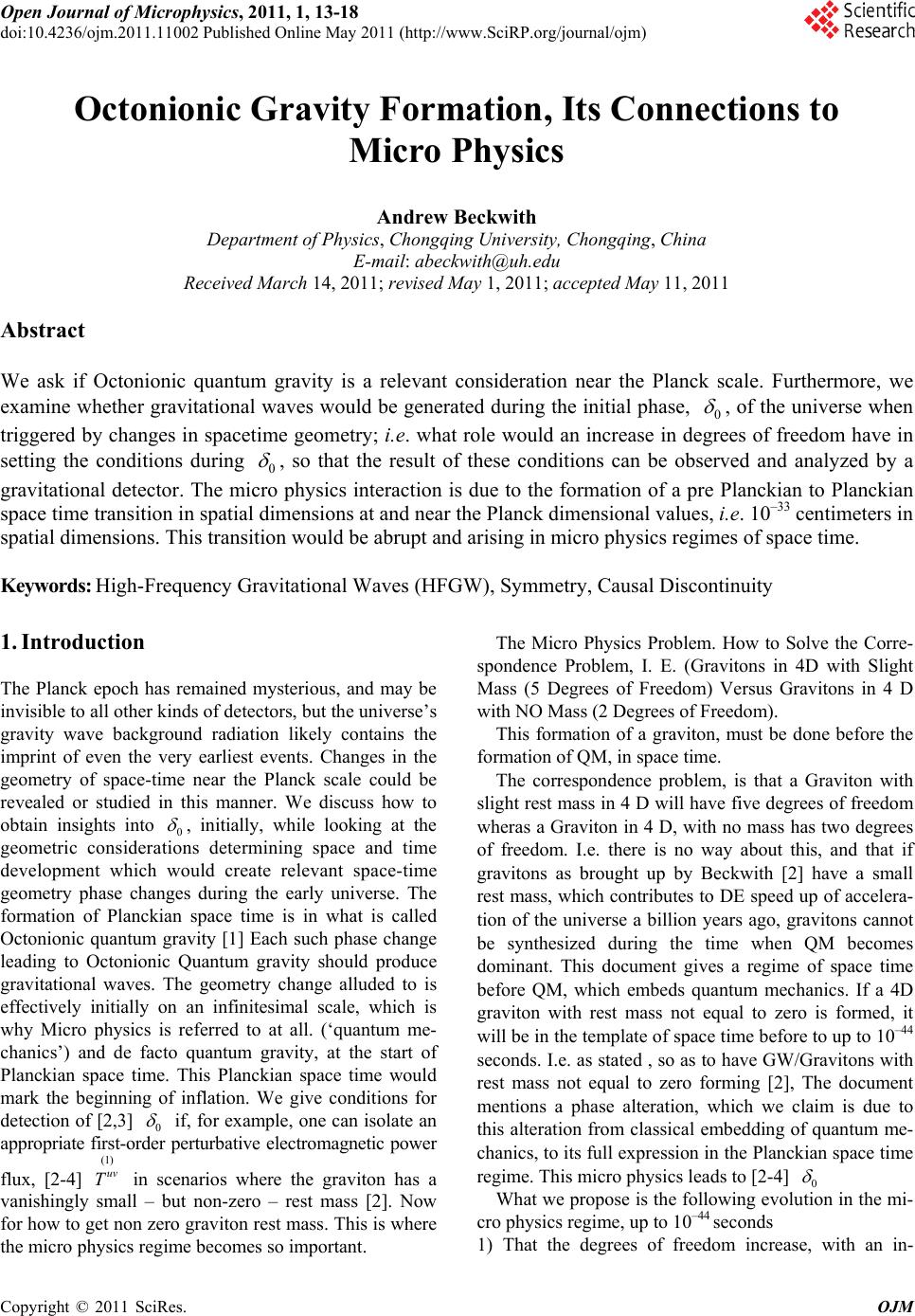 Open Journal of Microphysics, 2011, 1, 13-18 doi:10.4236/ojm.2011.11002 Published Online May 2011 (http://www.SciRP.org/journal/ojm) Copyright © 2011 SciRes. OJM Octonionic Gravity Formation, Its Connections to Micro Physics Andrew Beckwith Department of Physics, Chongqing University, Chongqing, China E-mail: abeckwith@uh.edu Received March 14, 2011; revised May 1, 2011; accepted May 11, 2011 Abstract We ask if Octonionic quantum gravity is a relevant consideration near the Planck scale. Furthermore, we examine whether gravitational waves would be generated during the initial phase, 0 , of the universe when triggered by changes in spacetime geometry; i.e. what role would an increase in degrees of freedom have in setting the conditions during 0 , so that the result of these conditions can be observed and analyzed by a gravitational detector. The micro physics interaction is due to the formation of a pre Planckian to Planckian space time transition in spatial dimensions at and near the Planck dimensional values, i.e. 10–33 centimeters in spatial dimensions. This transition would be abrupt and arising in micro physics regimes of space time. Keywords: High-Frequency Gravitational Waves (HFGW), Symmetry, Causal Discontinuity 1. Introduction The Planck epoch has remained mysterious, and may be invisible to all other kinds of detectors, but the universe’s gravity wave background radiation likely contains the imprint of even the very earliest events. Changes in the geometry of space-time near the Planck scale could be revealed or studied in this manner. We discuss how to obtain insights into 0 , initially, while looking at the geometric considerations determining space and time development which would create relevant space-time geometry phase changes during the early universe. The formation of Planckian space time is in what is called Octonionic quantum gravity [1] Each such phase change leading to Octonionic Quantum gravity should produce gravitational waves. The geometry change alluded to is effectively initially on an infinitesimal scale, which is why Micro physics is referred to at all. (‘quantum me- chanics’) and de facto quantum gravity, at the start of Planckian space time. This Planckian space time would mark the beginning of inflation. We give conditions for detection of [2,3] 0 if, for example, one can isolate an appropriate first-order perturbative electromagnetic power flux, [2-4] in scenarios where the graviton has a (1) uv T vanishingly small – but non-zero – rest mass [2]. Now for how to get non zero graviton rest mass. This is where the micro physics regime becomes so important. The Micro Physics Problem. How to Solve the Corre- spondence Problem, I. E. (Gravitons in 4D with Slight Mass (5 Degrees of Freedom) Versus Gravitons in 4 D with NO Mass (2 Degrees of Freedom). This formation of a graviton, must be done before the formation of QM, in space time. The correspondence problem, is that a Graviton with slight rest mass in 4 D will have five degrees of freedom wheras a Graviton in 4 D, with no mass has two degrees of freedom. I.e. there is no way about this, and that if gravitons as brought up by Beckwith [2] have a small rest mass, which contributes to DE speed up of accelera- tion of the universe a billion years ago, gravitons cannot be synthesized during the time when QM becomes dominant. This document gives a regime of space time before QM, which embeds quantum mechanics. If a 4D graviton with rest mass not equal to zero is formed, it will be in the template of space time before to up to 10–44 seconds. I.e. as stated , so as to have GW/Gravitons with rest mass not equal to zero forming [2], The document mentions a phase alteration, which we claim is due to this alteration from classical embedding of quantum me- chanics, to its full expression in the Planckian space time regime. This micro physics leads to [2-4] 0 What we propose is the following evolution in the mi- cro physics regime, up to 10–44 seconds 1) That the degrees of freedom increase, with an in-  A. BECKWITH 14 crease in temperature, during a transition to a Rindler Geometry flat space regime of space time. As given in Equation (16), with increasing temperature, more degrees of freedom unfold from a topological transi- tion. Degrees of freedom likely approach a maxima as temperature does, but this is a subject needing ex- perimental exploration and verification. 2) That for low but non zero initial temperature, the so called cold universe model, in pre space time in the pre Planckian regime, one has initially a huge degree of generated entropy. At the same time, we have about 2 degrees of freedom, with complex geometry in each geometrical slot, geoinfometric instantiation, or “infometron” of space time, which large quantities of stored entropy enveloped in the ‘crevices’ between infometrons, or lattice points. 3) Low degrees of freedom for low temperature corre- sponds to a complex geometry storing large amounts of total entropy in a complex geometric structure, and that later the entropy is released, with a break down of this complex geometric structure, i.e. equivalent to having many lattices, highly ordered, with low de- grees of freedom per ‘lattice’, to many degrees of freedom (DOF) as space time ‘lattices’ are broken, releasing entropy. The analogy is not perfect, but ap- proximates what would happen as one goes from complex curved space geometry with many ‘crevices’ for storage of entropy, which are released, “appar- ently” leading to a lot of entropy,. Further elaboration of what is being brought up is tied in with mutually unbiased basis (MUB), [5] .The values of 0 are set by the difference between Renyi entropy [6], and a particle count version of entropy, i.e. Sn. Are predictions also possible regarding signal strength of evolutionary artifacts of early universe HFGW? Again, yes. What we are talking about is the break down, due to thermal heat flux of an initial mutually unbiased basis set for a very complex initial geometry, and a reconstitution of space time geometry in flat Euclidian space time re- gime. The topological transition is due to a change in basis / geometry from the regime of Renyi entropy [6]to entropy in a particle count version of entropy, i.e. Sn. The choice of a Gaussian mapping, with two variable inputs, as given by Equation (16) below is done as a simplest case model. We will model inputs into the ini- tial value of as high energy fluctuations, and see if they contribute to examination of the formation of non commutative geometry in the beginning/just before the inflationary era. 1.1. First, Thermal Input into the New Universe. In Terms of Vacuum Energy We will briefly allude to temperature drivers which may say something about how thermal energy will be intro- duced into the onset of a universe. This will be the ‘thermal driver’ for the increase in degrees of freedom. Begin first with looking at different value of the cosmo- logical vacuum energy parameters, in four and five di- mensions [7] 5dim1 1cT (1) in contrast with the more traditional four-dimensional version of the same, minus the minus sign of the brane world theory version. as given by Park [8] 4dim 2 cT (2) Right after the gravitons are released, one still sees a drop-off of temperature contributions to the cosmological constant .Then for time values1 P tt , and integer n [7] 1 01 4dim 5dim 1 1n (3) In terms of its import the following has been suggested in the initial phases of the big bang, with large vacuum energy and 0, 01at at , the following relation, which violates (signal) causality, is obtained for small fluctuation P at l If we examine 5dim 2 cT We assume in this that we have, a discontinuity in the pre Planckian regime, for scale factors [7]. 1( )1 at tval ue at (4) Furthermore, in the transition for 0 P tt the fol- lowing increase in degrees of freedom is driven by ther- mal energy from a prior universe starting with [9] 0 1 2 thermalB temperature EkT T (5) The assumption is that there is an initial fixed entropy arising, with N as a nucleated structure in short time interval as temperature ar- rives. 19 0,10 temperature TG eV If the inputs into the inflaton , as given by a random influx of thermal energy from temperature, we will see the particle count on the right hand side of Equation (13) 2 22 22 1612161 24π4π4π Planck STk M (6) Copyright © 2011 SciRes. OJM 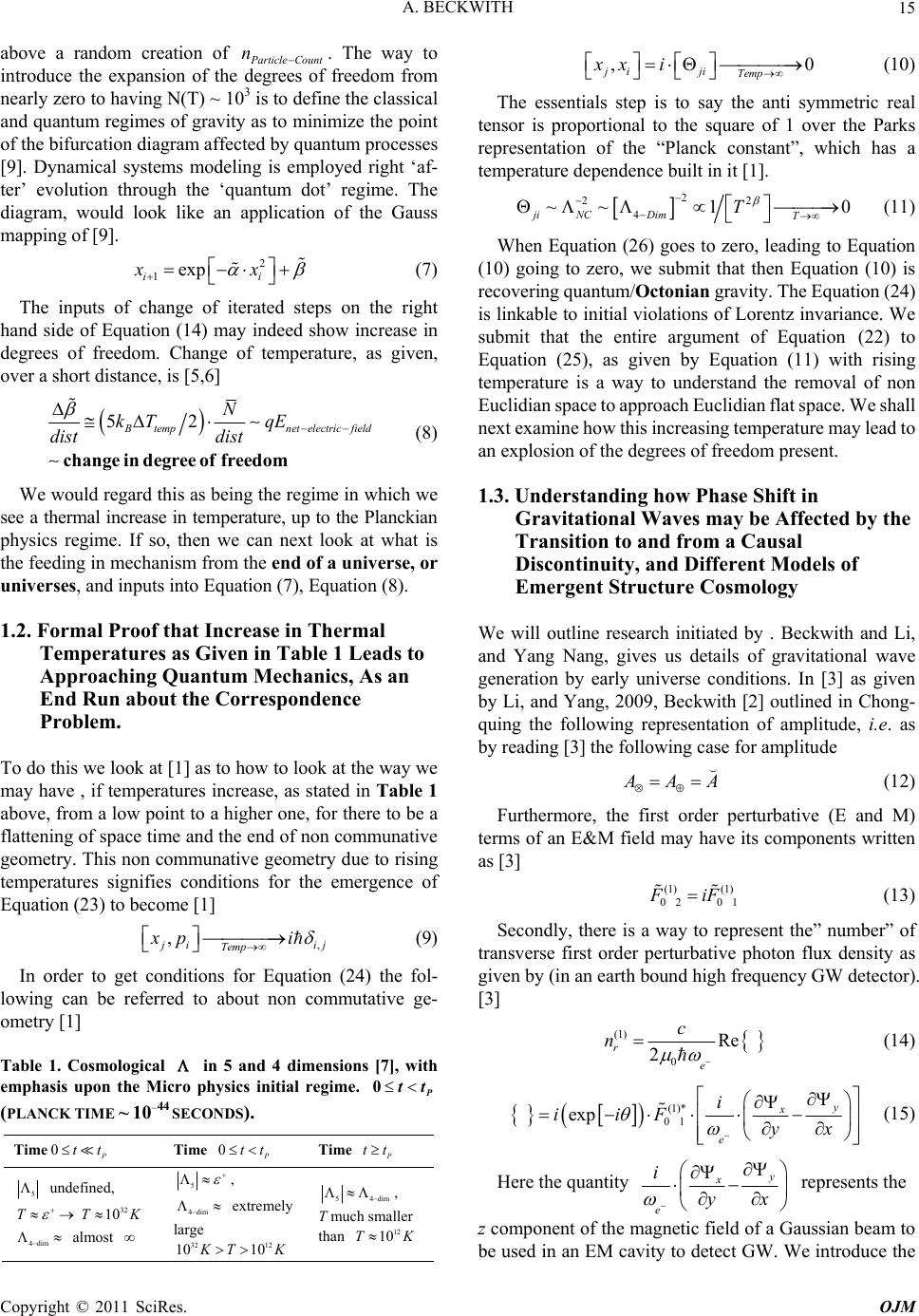 A. BECKWITH15 above a random creation of P article Count n e degrees of . The way to introduce the expansion of thfreedom from 3 is to definearly zero to having N(T) ~ 10ne the classical and quantum regimes of gravity as to minimize the point of the bifurcation diagram affected by quantum processes [9]. Dynamical systems modeling is employed right ‘af- ter’ evolution through the ‘quantum dot’ regime. The diagram, would look like an application of the Gauss mapping of [9]. 2 expxx 1ii (7) The inputs of change of iterated st hand side of Equation (14) may indeed s de eps on the right how increase in grees of freedom. Change of temperature, as given, over a short distance, is [5,6] 52 B temp N kT dist di netelectricfield qE st change in degree of freedom (8) We would regard this as being the regime in which we see a thermal increase in temperature, up to the Planckian ph Temperatures as Given in Table 1 Leads to n To d[1] as to how to look at the way we may have , if temperatures increase, as stated in Table 1 ysics regime. If so, then we can next look at what is the feeding in mechanism from the end of a universe, or universes, and inputs into Equation (7), Equation (8). 1.2. Formal Proof that Increase in Thermal Approaching Quantum Mechanics, As a End Run about the Correspondence Problem. o this we look at above, from a low point to a higher one, for there to be a flattening of space time and the end of non communative geometry. This non communative geometry due to rising temperatures signifies conditions for the emergence of Equation (23) to become [1] ,, j i Te xpi ij mp (9) In order to get conditions for Equation lowing can be referred to about non comm om smological in 5 and 4 dimensions [7], with phasis upon the Michysics initial regime. (24) the fol- utative ge- etry [1] Table 1. Co ro pem 0P tt (PLANCK TIME ~ 10–44 S CONDS). Time0 E P tt Time 0 P tt Time P tt 5 undefined, T 32 10T almost ,0 jiji Temp xx i (10) The essentials step is to imetric rl tensor is proportional to the square of 1 over the Parks representation of the “Planck constnt”, which has a temperature dependence built in it [1]. say the ant symea a 2 22 4 ~~ 10 ji NCDimT T (11) When Equation (26) goes to zero, leading to Equation (10) going to zero, we submit that then Equation (10) is recovering quantum/Octonian gravity. The Equation (24) is linkable to initial violations of Lorentz invaria submit that the entire argument of Equation (22) to Eq f Emergent Structure Cosmology We and wave gene given by Led in Chong- quing the following representation of amplitude, i.e. as nce. We uation (25), as given by Equation (11) with rising temperature is a way to understand the removal of non Euclidian space to approach Euclidian flat space. We shall next examine how this increasing temperature may lead to an explosion of the degrees of freedom present. 1.3. Understanding how Phase Shift in Gravitational Waves may be Affected by the Transition to and from a Causal Discontinuity, and Different Models o will outline research initiated by . Beckwith and Li, Yang Nang, gives us details of gravitational ration by early universe conditions. In [3] as i, and Yang, 2009, Beckwith [2] outlin by reading [3] the following case for amplitude A AA (12) Furthermore, the first order perturbative (E and M) terms of an E&M field may have its components written as [3] (1) 0 20 (1) 1 F iF (13) Secondly, there is a way to represent the” number” of transverse first order perturbative photon flux density as given by (in an earth bound high frequency GW detector). [3] (1) 0 Re 2 r e c n (14) (1)* 0 1 exp y x e i iiF yx (15) Here the quantity y x e i yx K 4dim 5 , extremy large 4dim el 32 12 10 10 K T K 54 , dim T much smaller than 10 TK12 represents the z component of the magnetic field of a Gaussian b be used in an EM cavity to detect GW. We introduce the eam to Copyright © 2011 SciRes. OJM 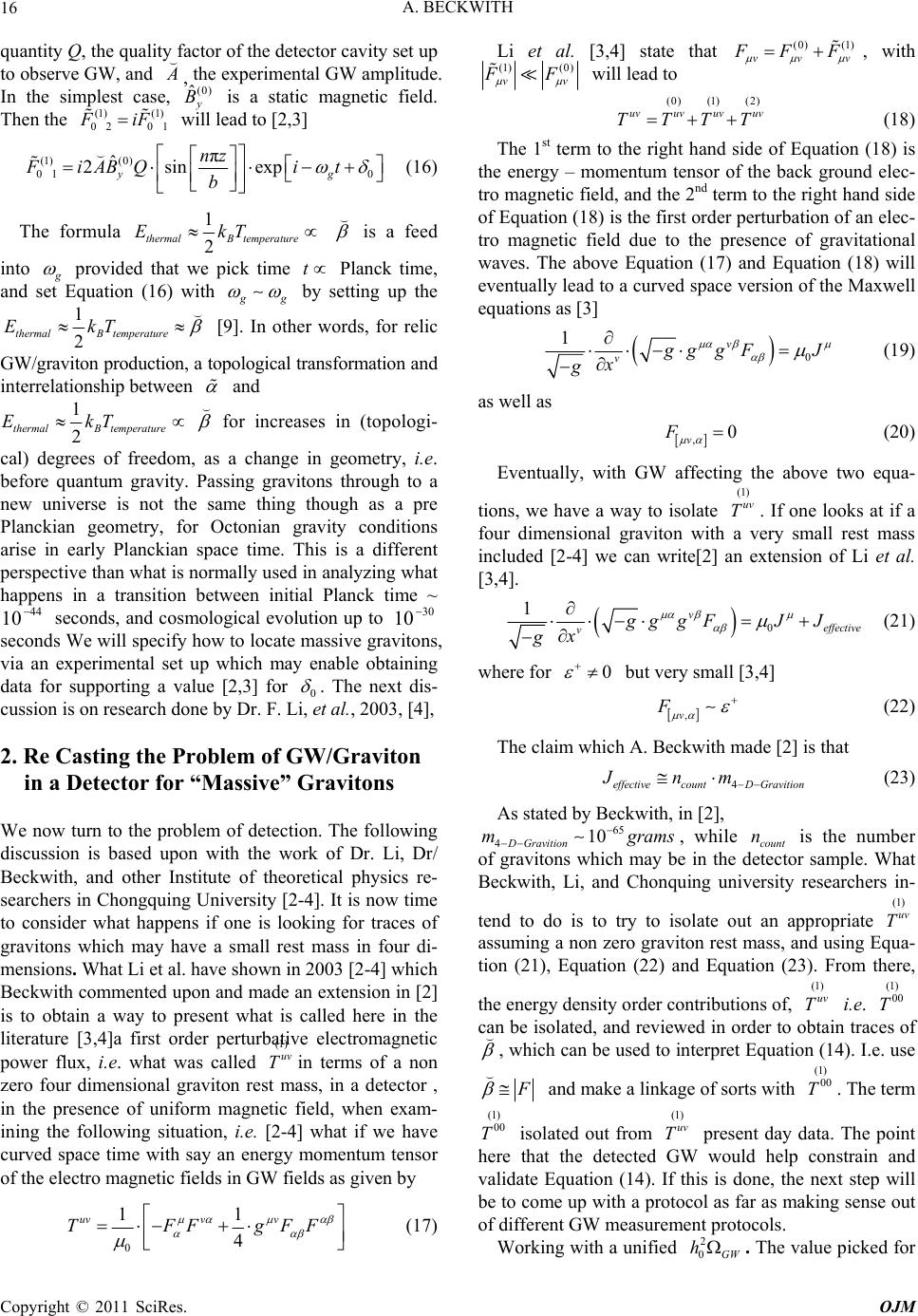 A. BECKWITH 16 quy factor of the dete to antity Q, the qualitctor cavity set up observe GW, and A , the experimental GW amplitude. In the simplest case, (0) ˆ y B is a static magnetic field. Then the (1) (1) 0 20 1 F iF will lead to [2,3] (1) (0) 0 10 π ˆ 2snexp yg nz FiABQit b i rmula (16) The fo1 aB temperature kT 2 therm l E is a feed into g provided that we pick time Planc and set Equation (16) with tk time, g g by setting up the 1 2 thermalB temp T erature Ek ds, for relic [9]. In other wor raranGW/gviton production, a topological tsformation and interrelationship between and 1 2 thermalB temperature EkT for increases in (topologi- cal) degrees of freedom, as a change in geometry, i.e. before quantum gravity. Passing gravitons through to a new univis not the same thinerse g though as a pre Planckian geometry, f or Octonian gravity conditions arise in early Planckian space time. This is a different perspective than what is normally used in analyzing what happens in a transition between initial Planck time ~ 44 10 seconds, and cosmological evolution up to 30 10 seconds We will specify how to locate massive gravitons, via an experimental set up which may enable obtaining data for supporting a value [2,3] for 0 . The next dis- cussion is on research done by Dr. F. Li, et al., 2003, [4], 2. Re Casting the Problem of GW/Graviton in a Detector for “Massive” Gravitons We now turn to the problem of detection. The following / - sea time gy discussion is based upon with the work of Dr. Li, Dr Beckwith, and other Institute of theoretical physics re rchers in Chongquing University [2-4]. It is now to consider what happens if one is looking for traces of gravitons which may have a small rest mass in four di- mensions. What Li et al. have shown in 2003 [2-4] which Beckwith commented upon and made an extension in [2] is to obtain a way to present what is called here in the literature [3,4]a first order perturbative electromagnetic power flux, i.e. what was called (1) uv Tin terms of a non zero four dimensional graviton rest mass, in a detector , in the presence of uniform magnetic field, when exam- ining the following situation, i.e. [2-4] what if we have curved space time with say an ener momentum tensor of the electro magnetic fields in GW fields as given by 0 11 4 uvv v TFFgFF (17) Li et al. [3,4] state that (0) (1) vv v F FF , with (1) (0) vv F F will lead to (0) (1) uvuv uv uv TTTT (2) The 1st term to the right hand side of Equation (18) is thf the back groun tro magnetic 2 term to the right hand side of Equation (18) is the first order perturbation of an elec- tro magnetic field due to the presen w (18) e energy – momentum tensor od elec- field, and the nd ce of gravitational aves. The above Equation (17) and Equation (18) will eventually lead to a curved space version of the Maxwell equations as [3] 0 1v v g ggF J x g (19) as well as ,0 v F (20) Eventually, with GW affecting the above ve a way to isolate If one looks at if a sional graviton with a very small rest mass included [2-4] we can write[2] an [3,4] two equa- tions, we ha four dimen (1) uv T. extension of Li et al. . 0effecti ve vgggFJJ x g 1v (21) where for 0 but very small [3,4] ,v F (22) The claim which A. Beckwith made [2] is that 4effectivecountDGravition Jnm (23) As stated by Beckwith, in [2], grams, while Be tenut an appropriate as ass, and u of 65 410 DGravition m of count n is the number gravitons which may be in the detector sample. What ckwith, Li, and Chonquing university researchers in- d to do is to try to isolate o suming a non zero graviton res (1) uv T t msing Equa- tion (21), Equation (22) and Equation (23). From there, the energy density order contributions of, (1) uv T i.e. (1) 00 T can be isolated, and reviewed in order to obtain traces , which can be used to interpret Equation (14). I.e. use F and make a linkage of sorts with (1) 00 T. The term (1) 00 T isolated out from (1) uv T present day dhe ata. Tpoint va be to cosen of diffe Working with a unified The value picked for here that the detected GW would help constrain and lidate Equation (14). If this is done, the next step will me up with a protocol as far as making se out rent GW measurement protocols. 2 0GW h. Copyright © 2011 SciRes. OJM 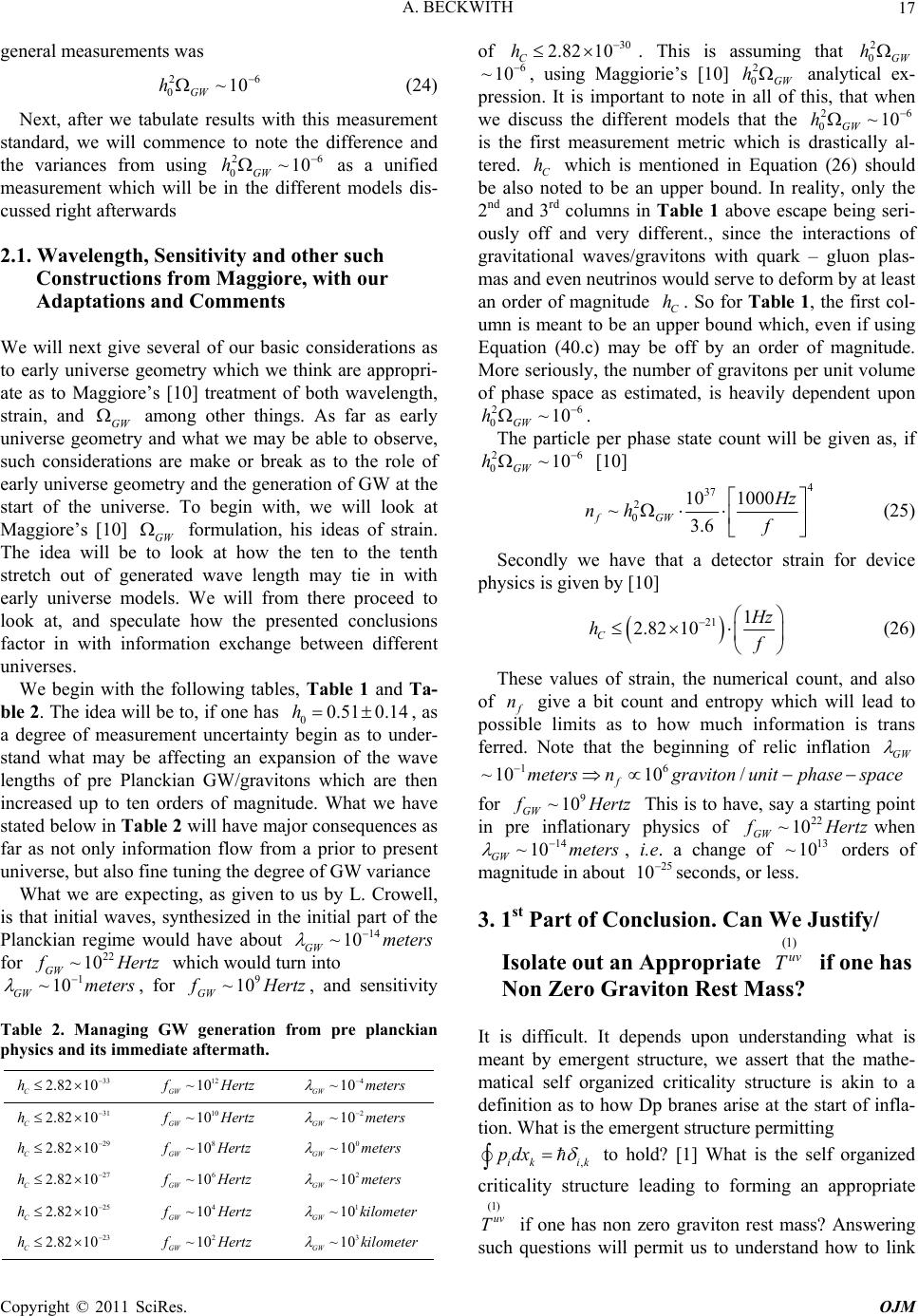 A. BECKWITH17 m 2.1. Wavelength, Sensitivity a ] treatment of both wavelength, early serve, suchle of earlyation of GW at the generaleasurements was 26 0~10 GW h (24) Next, after we tabulate results with this measurement standard, we will commence to note the difference and the variances from using 26 0~10 GW h as a unified measurement which will be in the different models dis- cussed right afterwards nd other such Constructions from Maggiore, with our Adaptations and Comments We will next give several of our basic considerations as to early universe geometry which we think are appropri- ate as to Maggiore’s [10 strain, and GW among other things. As far as universe geometry and what we may be able to ob considerations are make or break as to the ro universe geometry and the gener start of the universe. To begin with, we will look at Maggiore’s [10] GW formulation, his ideas of strain. The idea will be to look at how the ten to the tenth stretch out of generated wave length may tie in with early universe models. We will from there proceed to look at, and speculate how the presented conclusions factor in with information exchange between different universes. We begin with the following tables, Table 1 and Ta- ble 2. The idea will be to, if one has 00.51 0.14h, as a degree of measurement uncertainty begin as to under- stand what may be affecting an expansion of the wave lengths of pre Planckian GW/gravitons which are then increased up to ten orders of magnitude. What we have stated below in Table 2 will have major consequences as far as not only information flow from a prior to present universe, but also fine tuning the degree of GW variance What we are expecting, as given to us by L. Crowell, is that initial waves, synthesized in the initial part of the Planckian regime would have about 14 ~10 GW meters for 22 ~10 GW f Hertz which would turn into 1 ~10 GW meters , for 9 ~10 GW f Hertz, and sensitivity Table 2. Managing GW generation from pre planckian physics and its immediate aftermath. 33 2.82 10 C h 12 ~10 GW f Hertz 4 ~10 GW meters 31 2.82 10 C h 10 ~10 GW f Hertz 2 ~10 GW meters 29 2.82 10 C h8 ~10 GW f Hertz 0 ~10 GW meters 27 2.82 10 C h 6 ~10 GW f Hertz 2 ~10 GW meters 25 2.82 10 C h 4 ~10 GW f Hertz 1 ~10 GW kilo meter 23 2 2.82 10 C h ~10 GW f Hertz 3 ~10 GW kilometer 30 2.82 0 C h. This is assuming that 2 0 h of 1 6GW ~10 , using Magg . It is por discuss the differen iorie’s [10] analy tant to note t models th 2 0GW h i all of this, th at the tical at when 26 ~ GW ex- pression imn we 0 h10 is drastically al- n (26 eality, on , the fi ) should ly the pe being seri- ons of rst col- is th tered be 2nd e first mesurem . C h which is m also noted t be and 3rd columns in ly off and very vita n aent metr entioned i an upper b Table 1 ic which Equatio ound. In r above esca quark n o ous different., since the interacti grational waves/gravitons with – gluon plas- mas and even neutrinos would serve to deform by at least an order of magnitude C h. So for Table 1 umn is meant to be an upper bound which, even if using Equatio(40.c) may be off by an order of magnitude. More seriously, the number of gravitons per unit volume of phase space as estimated, is heavily dependent upon 26 0~10 GW h . The particle per phase state count will be given as, if 26 0~10 GW h [10] 4 37 2 0 10 1000 ~3.6 fGW H z nh f (25) Secondly we have that a detector strain for device physics is given by [10] 21 1 2.82 10 C H z h f (26) These values of strain, the numerical count, and also of f n ssibl give a bit count and entropy which poe limits as to how much information is trans fe will lead to rred. Note that the beginning of relic inflation GW 16 ~10 10 f meters n /graviton unitphase 9 space for ~10 GW f Hertz in pre inflationary physics of This is to have, say a starting point 22 10~ GW f Hertz when 14 ~10 , GW meters i.e. a change of ders of magnitude in about 25 10 13 ~10 or seconds, or less. 3. 1st Part of Conclusion. Can We Justify/ Isolate out an Appropriate if one ha on Zero Gra It is difficult. It tandi strucat the mathe- matical self organized criticality structure is akin to a fla- Wh itting (1) uv T s Nviton Rest Mass? depends upon undersng what is meant by emergent ture, we assert th definition as to how Dp branes arise at the start of in tion. at is the emergent structure perm ,ik ik pdx to hold? [1] What is ticality structure leading to forming an the self organized cri appropriate (1) uv T if one has non zero graviton rest mass? Answering such questions will permit us to understand how to link Copyright © 2011 SciRes. OJM 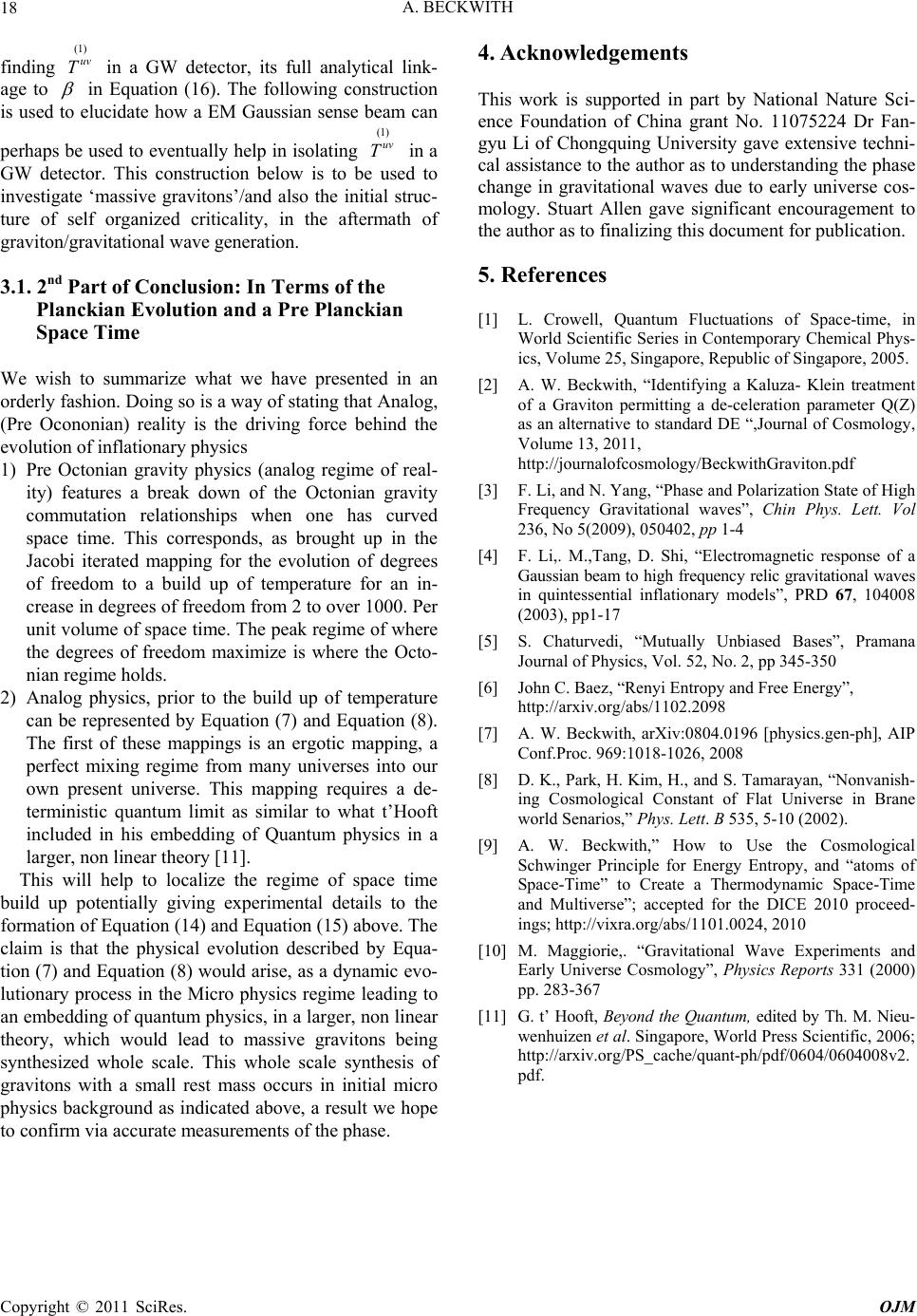 A. BECKWITH Copyright © 2011 SciRes. OJM 18 finding (1) uv T in a GW detector, its full analytical link- age to in Equation (16). The following construction is used to elucid GW detector. This construction below is to be used to inve /gra ity c space timrresponds, as brought up in the sy chni- cal assistance to the author as to understanding the phase s due to early universe cos- gnificant encouragement to [2] A. W. Beckwith, “Identifying a Kaluza- Klein treatment permitting a de-celeration parameter Q(Z) e to standard DE “,Journal of Cosmology, 104008 018-1026, 2008 n Brane Use the Cosmological ate how a EM Gaussian sense beam can (1) perhaps be used to eventually help in isolating uv T in a stigate ‘massive gravitons’/and also the initial struc- ture of self organized criticality, in the aftermath of gravitonvitational wave generation. 3.1. 2nd Part of Conclusion: In Terms of the Planckian Evolution and a Pre Planckian Space Time We wish to summarize what we have presented in an orderly fashion. Doing so is a way of stating that Analog, (Pre Ocononian) reality is the driving force behind the evolution of inflationary physics 1) Pre Octonian gravity physics (analog regime of ity) features a break down of the Octonian grav ommutation relationships when one has curve e. This co real- Volume 13, 2011, http://journalofcosmology/BeckwithGraviton.pdf [3] F. Li, and N. Yang, “Phase and Polarization State of High d Fr Jacobi iterated mapping for the evolution of degrees of freedom to a build up of temperature for an in- crease in degrees of freedom from 2 to over 1000. Per unit volume of space time. The peak regime of where the degrees of freedom maximize is where the Octo- nian regime holds. 2) Analog physics, prior to the build up of temperature can be represented by Equation (7) and Equation (8). The first of these mappings is an ergotic mapping, a perfect mixing regime from many universes into our own present universe. This mapping requires a de- terministic quantum limit as similar to what t’Hooft included in his embedding of Quantum physics in a larger, non linear theory [11]. This will help to localize the regime of space time build up potentially giving experimental details to the formation of Equation (14) and Equation (15) above. The claim is that the physical evolution described by Equa- tion (7) and Equation (8) would arise, as a dynamic evo- lutionary process in the Micro physics regime leading to an embedding of quantum physics, in a larger, non linear theory, which would lead to massive gravitons being nthesized whole scale. This whole scale synthesis of gravitons with a small rest mass occurs in initial micro physics background as indicated above, a result we hope to confirm via accurate measurements of the phase. 4. Acknowledgements This work is supported in part by National Nature Sci- ence Foundation of China grant No. 11075224 Dr Fan- gyu Li of Chongquing University gave extensive te change in gravitational wave mology. Stuart Allen gave si the author as to finalizing this document for publication. 5. References [1] L. Crowell, Quantum Fluctuations of Space-time, in World Scientific Series in Contemporary Chemical Phys- ics, Volume 25, Singapore, Republic of Singapore, 2005. of a Graviton as an alternativ equency Gravitational waves”, Chin Phys. Lett. Vol 236, No 5(2009), 050402, pp 1-4 [4] F. Li,. M.,Tang, D. Shi, “Electromagnetic response of a Gaussian beam to high frequency relic gravitational waves in quintessential inflationary models”, PRD 67, (2003), pp1-17 [5] S. Chaturvedi, “Mutually Unbiased Bases”, Pramana Journal of Physics, Vol. 52, No. 2, pp 345-350 [6] John C. Baez, “Renyi Entropy and Free Energy”, http://arxiv.org/abs/1102.2098 [7] A. W. Beckwith, arXiv:0804.0196 [physics.gen-ph], AIP Conf.Proc. 969:1 [8] D. K., Park, H. Kim, H., and S. Tamarayan, “Nonvanish- ing Cosmological Constant of Flat Universe i world Senarios,” Phys. Lett. B 535, 5-10 (2002). [9] A. W. Beckwith,” How to Schwinger Principle for Energy Entropy, and “atoms of Space-Time” to Create a Thermodynamic Space-Time and Multiverse”; accepted for the DICE 2010 proceed- ings; http://vixra.org/abs/1101.0024, 2010 [10] M. Maggiorie,. “Gravitational Wave Experiments and Early Universe Cosmology”, Physics Reports 331 (2000) pp. 283-367 [11] G. t’ Hooft, Beyond the Quantum, edited by Th. M. Nieu- wenhuizen et al. Singapore, World Press Scientific, 2006; http://arxiv.org/PS_cache/quant-ph/pdf/0604/0604008v2. pdf. |

